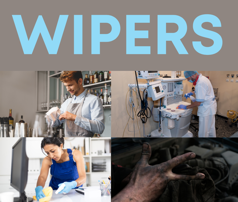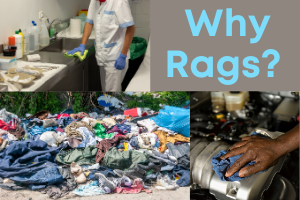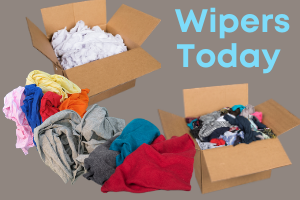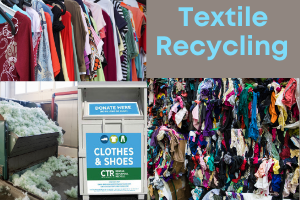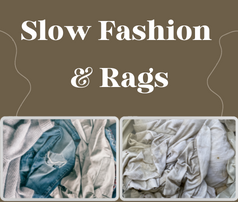 Fast Fashion
Fast Fashion
Slow Fashion & Rags

In our post a few months ago, we introduced the term “slow fashion,” discussing what it means, how it’s different from fast fashion and why it is important to choose slow fashion when making decisions on what clothing to purchase. In this blog we hope to discuss another large reason slow fashion is so important, which is that the slow fashion movement is paramount for the rag and recycling industries directly.
Our parent company, Wipeco, Inc. is a supply company that focuses on providing quality wiping rags to those in the industrial, manufacturing and janitorial industries. And quality is of utmost importance when creating rags from pre-consumer waste and post-consumer used textiles. For the history of wiping rags and the role they have played across the years, check out our blog post, “Wipers”.
Quality Matters
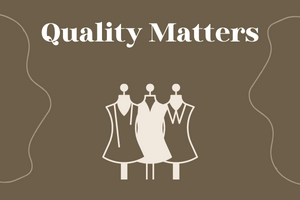
Why is quality so important when it comes to creating wiping rags? Clothing that is poorly made doesn’t make good rags.
“The days of recycled 100 percent cotton wiping rags are pretty much over, and so are the days when wiping rag manufacturers could rely on industry specifications. The problem is that clothes and textiles simply aren’t as well made as they used to be. A shirt that falls apart after a few washes can’t be transformed into a rag suitable for wiping down a freshly washed car or a restaurant table. Cheap fast fashion isn’t just hurting thrift shops; it’s hastening a garment’s trip to the landfill or garbage incinerator.” (“Secondhand: Travels in the New Global Garage Sale”, Minter, p 162)
This is why slow fashion is so important for the wiping rag industry. When consumers choose to care about the quality of their clothing and how it is made and the people who make it, everyone wins. The consumer wins by having a quality item that will last wash after wash and one that they can feel good about buying. The secondhand store wins when the consumer no longer needs that item as it will be in good condition to be resold or sent to a grader. The wiping rag supplier wins by having quality material to sell to industries in need of rags. Because the clothes last longer there is greater demand for second-hand wear in the export market AND it is less labor intensive to sort, as there is a greater percentage of rewearable or reusable items.
Fabric Matters – Polyester vs Cotton
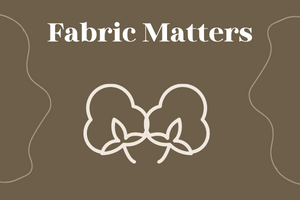
When it comes to wiping rags, the type of fabric matters. Depending on what the rag is needed for, different fabrics will absorb and clean in different ways. Cotton is stronger and more absorbent than polyester, so allows for greater reuse. “When assessing if an old garment will make a useful rag, [Nicole Malalieu, a fashion lecturer at Australian College of the Arts] says “to steer clear of anything that’s polyester or synthetic because it just doesn’t absorb as well”. (Found Here)
Polyester and polyester blends have multifaceted challenges in terms of recycling and reuse of fabric. Polyester and even polyester blended fabrics prove ineffective for use in the wiping rag industry, causing their end of life as a textile to come much sooner than other naturally made fabrics such as cotton. The problems with polyester continue as laundering this fabric releases microplastics into the water and it does not naturally biodegrade in landfills as other textiles would – 100% cotton for example.
Some might ask, “But what about its ability to be recycled again and again into new garments?” Though it may seem a greener alternative due to this possibility, there is no current strategy for efficient separation of blended fabrics such as polyester. In contrast, 100% cotton has multiple reuse options as the absorbent material makes it highly desirable for breathability and absorption, etc.
Slow Matters
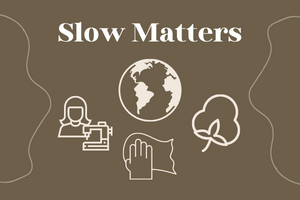
From caring for the quality of life of textile workers to caring for the environment and the life of a textile, slow fashion is a win-win for everyone.
- The textile worker wins by being given a safe place to work and liveable wages.
- The environment wins by having less of its resources used or polluted.
- The consumer wins by having a unique, quality piece of clothing to wear that will last longer than fast fashion pieces.
- The resale store wins by having quality clothing to resell for better prices.
- The wiping rag supplier wins by having better quality wiping rags to supply to industries they serve.
- And the environment wins yet again by having biodegradable textiles in landfills at their end of life versus ones that don’t break down.
It is easy to see that slow fashion is the best choice. As you look to purchase new clothing in the future, please consider long term benefits and choose slow fashion retailers that help all of us benefit.
